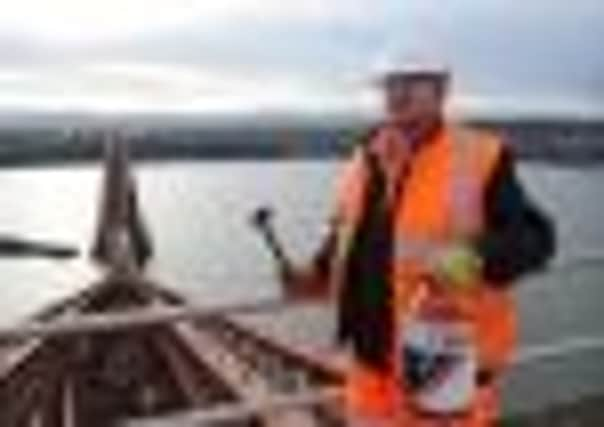Forth wonder of the world finished


But after hundreds of thousands of litres of paint and a decade’s hard graft, one of Scotland’s most iconic landmarks has been returned to its original splendour.
The painting of the Forth Bridge was finally completed yesterday, bringing to an end the enduring myth that the nation’s largest listed building is ceaselessly painted from end to end.
Advertisement
Hide AdAdvertisement
Hide AdThe completion of the work will allow the structure – a working monument to the skill of British railway engineering – to stand scaffold-free for the first time in more than ten years.
It was a Herculean task, described by officials as one of the “biggest engineering challenges” of the modern age, but the £130 million repair and repainting project was finished ahead of schedule.
Those behind the endeavour held a modest presentation yesterday morning, inviting members of the media to the 110-metre summit of the bridge’s 53,000 tonnes of steel to see for themselves the scale of the work.
Over the life of the project, more than 1,500 people worked on the structure, with up to 400 people a day on the bridge at the height of the refurbishment works, applying a triple layer of new glass flake epoxy paint.
The paint creates a chemical bond to provide a virtually impenetrable layer which will protect the bridge’s steelwork from the worst of the elements.
David Simpson, Network Rail’s route managing director for Scotland, said: “The completion of this refurbishment will safeguard the future of one of the country’s most famous landmarks.
“Repainting the bridge has long been considered one of the world’s never-ending tasks, and the refurbishment programme we have just completed has been one of the biggest engineering challenges Network Rail has faced. Our staff and contractors can take real pride in their achievements on this project, not least in the fact that through their efforts this amazing structure will remain free of major maintenance work for at least two decades.”
Marshall Scott, managing director of Balfour Beatty Regional Civil Engineering, the main contractor in the bridge restoration project, said the job paid tribute to those who first raised the bridge above the waters of the Firth of Forth.
Advertisement
Hide AdAdvertisement
Hide AdHe said: “Balfour Beatty is delighted to have played such a significant part in the restoration of the iconic Forth Bridge over the last ten years.
“The now fully restored Forth Bridge will continue to operate for many decades to come and it will provide the world- renowned image that Scotland can be rightfully proud of.
“The work that Balfour Beatty Regional Civil Engineering has provided to restore the Forth Bridge back to its original condition will remain as part of a legacy and a testament to the skills and expertise of those who built this much treasured structure more than a century ago.”
Having watched the vast undertaking from a prime location, residents in North Queensferry welcomed the restoration.
Iain Mitchell, vice chair of North Queensferry Community Council, said: “It’s lovely to see the work finished and we’re looking forward to getting the area around the base of the cantilever back into use.”
Mr Mitchell also dismissed any suggestion the colour, which imitates the original red oxide used in 1890, had attracted critics.
“The colour is absolutely fine, and for good historic reasons the original colour has been used, which is entirely appropriate.”
With the work finally completed, engineers will be back “from time to time” to maintain the most exposed sections of the structure, according to Network Rail, but the job of repainting the whole structure will, it is hoped, not be necessary for decades to come.
Mr Simpson said: “The paint system being used on the bridge has been used in the past on North Sea oil rigs. We expect it to last in excess of 20 years.”